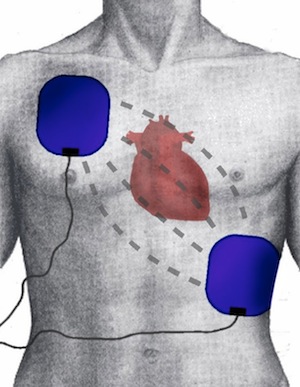
Pacing - DRAFT
last authored:
last reviewed:
Please Note: These resources are unfinished; please rely on other sources for your knowledge as well
Introduction

pacing pads, courtesy of PhilippN
Pacemakers are used to apply repeated electrical stimulation to the heart, predominantly during cases of bradycardia. Pacers can be temporary or permament.
Transcutaneous Pacing
Transcutaneous pacing (TCP) is used during advanced cardiac life support (ACLS) for treatment of symptomatic bradycardia with poor perfusion.
TCP shocks the heart through electrodes placed on the skin, normally by a manual defibrillators.
It is used in situations of:
- hemodynamically unstable bradycardia
- acute myocardial infarction, with sick sinus syndrome, Mobitz II second-degree AV block, third-degree AV block, or new bundle branch block
- bradycardia with symptomatic ventricular escape rhythms
While establishing TCP, ensure the 'pacer' mode is selected. Gradually increase the amplitude until ECG evidence of an increased heart rate (capture).
Confirm mechanical capture by assessing the radial pulse. Do not use the carotid pulse, as muscle activation caused by the pacing may mimic a pulse.
Conscious patients will require procedural sedation (i.e., benzodiazepines and opioids).
Current should be set at 2mA above dose at which consistent capture is observed for safety.
Contraindications to pacing include:
- severe hypothermia
- asystole
ECG Findings
A pacer spike shows up as a long line in the QR, or may be a little blip.
Transvenous Pacing
Permanent Pacemaker
